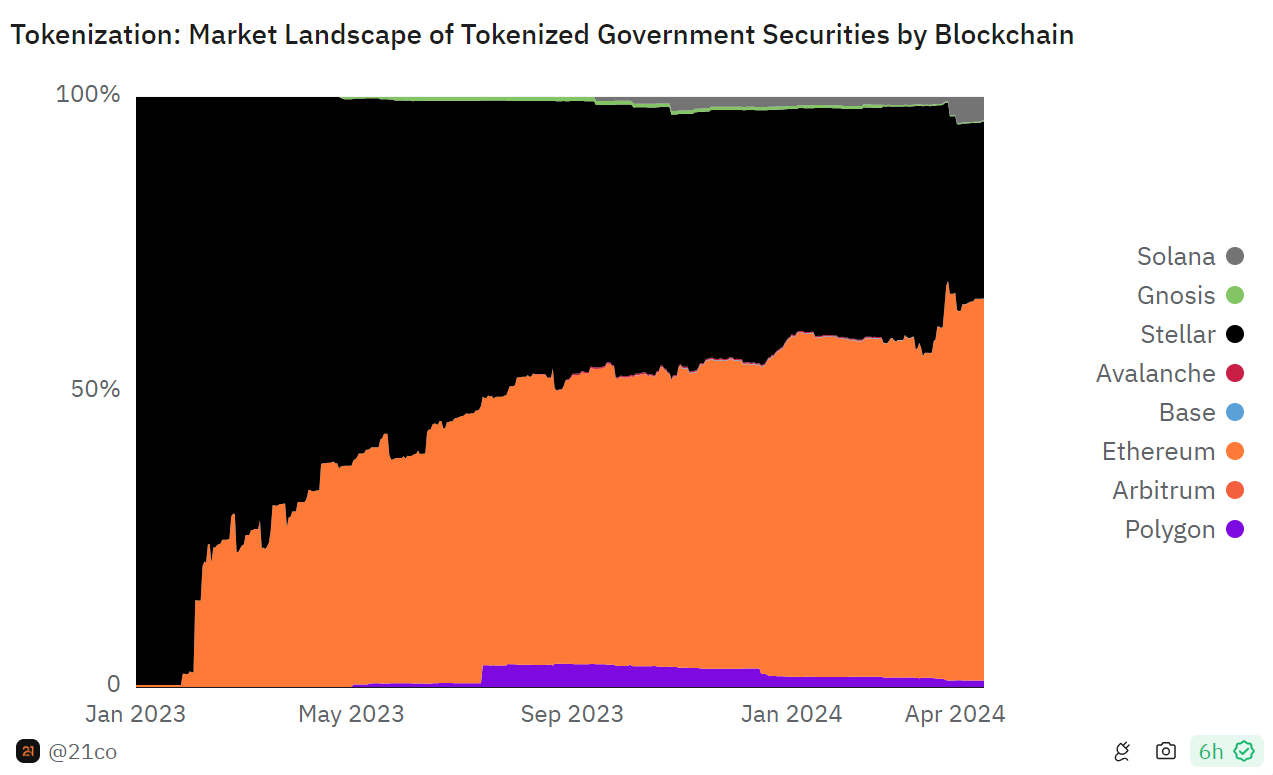Original | Odaily Planet Daily
Author | How to be a husband

As the most important component of the RWA sector, the current market size of tokenized government bonds has exceeded US$1 billion.
In particular, the entry of BlackRock after the new year has driven the rapid growth of this sector. In addition, Circle announced the launch of a smart contract transfer function for BlackRock's BUIDL fund, which optimized the RWA on-chain exit mechanism and resolved the market's worries.
Odaily Planet Daily will elaborate on the current market structure of tokenized treasury bonds in the RWA sector and the subsequent impact of Circle’s move on RWA.
Tokenized Treasury Bond Size Distribution
According to data analysis by 21.co on Dune , the current market size of tokenized government bonds has reached $1.1 billion, of which Franklin Templeton, BlackRock and Securitize, Ondo Finance and Superstate account for nearly 80% of the market share. The following will introduce them one by one.

Check out the top four projects
Franklin Templeton
Franklin Templeton was launched on the Stellar public chain in 2021 and later expanded to Polygon in April 2023. As of now, the fund has assets of approximately $363 million, accounting for 30.2% of the current market size. As it is the first tokenized fund on the market, the relevant system is not sound, and the BENJI token representing the shares of the Franklin Templeton fund cannot be transferred between holders, resulting in a relatively slow market size development in the past three years. However, according to official sources, Franklin Templeton has been offering fee discounts, and the discounts are subsidized by the government, which has certain government factors behind it.
BlackRock Tokenized Fund BUIDL
BlackRock's tokenized fund BUIDL was officially launched on Ethereum on March 20 this year, and was jointly issued with Securitize and operated and managed by BlackRock Financial Management, Inc. The fund's assets are approximately US$294 million, accounting for 24.4% of the current market size, but it is worth noting that the fund was issued less than a month ago and the market size has increased rapidly.
BUIDL mainly invests in cash, U.S. Treasury bonds and repurchase agreements. Fund investors must meet the qualifications of "qualified investors". Investors will receive BUIDL tokens of equal value, and each BUIDL token is worth $1. The tokens will be transferred to other verified addresses by Securitize's crypto wallet, but investors transfer BUIDL tokens, and the recipients must meet their review conditions. For details, please see the previous article "Raising more than $240 million in 7 days, the winner of BlackRock Fund BUIDL is Ondo"
Ondo Finance
Ondo Finance was engaged in the Laas (liquidity services) track in the early days, and then transformed to the RWA track in January 2023. The first products launched were OUSG (tokenized US bonds) and USDY (US dollar interest rate). According to the above figure, the current asset size of the fund is about 203 million US dollars, accounting for 17.1% of the total market size. It is also the leader of the on-chain RWA project.
The initial underlying assets of the tokenized U.S. Treasury product OUSG were mostly from BlackRock's short-term U.S. Treasury ETF: iShares Short Treasury Bond ETF (NASDAQ: SHV), and a small portion was USDC and USD as liquidity. But when BlackRock launched the tokenized fund BUIDL, it converted SHV into BUIDL and became the largest holder of the BUIDL fund. For details, please see the previous article "Detailed Explanation of Ondo Finance: Successful Transformation, TVL Jumped to the Top Three in the RWA Track"
Superstate
Superstate launched a tokenized U.S. Treasury fund product on Ethereum in February this year. The fund directly holds U.S. short-term Treasury bonds. Its goal is to provide returns consistent with the federal funds rate. Investors can deposit in U.S. dollars or Circle's USDC stablecoin and receive USTB tokens representing their investment in the fund. Users can custody the tokens themselves or choose the custody services of Superstate partners Anchorage Digital and BitGo. The current market size of the fund is approximately US$98 million, accounting for 8.1% of the total market size.
Public chain distribution of tokenized funds
According to 21.co's data analysis on Dune , Ethereum and Stellar occupy a higher share. Ondo uses Solana as its main battlefield, but in terms of market size, Solana ranks third. From the chart, Ethereum occupies the highest share because of the funds launched by BlackRock and Superstate this year. Stellar is the result of Franklin Templeton's years of accumulation, but the RWA projects currently launched on the chain are mostly focused on Solana, and Solana may continue to expand in the future.

Circle embraces BlackRock, tokenized government bonds may be further
Less than 20 days after the launch of the BlackRock fund, Circle announced the launch of a smart contract transfer function for the BlackRock BUIDL fund, allowing holders to transfer funds. The smart contract provides BUIDL investors with an instant, 24-hour BUIDL exit channel.
In other words, Circle acts as an exit channel between on-chain investors and BlackRock BUIDL. The current redemption mechanism of BlackRock BUIDL is that fund investors deposit BUIDL tokens into the partner Securitize address 0x878…200, and then transfer them to the black hole through this address for destruction. However, this process requires time for review and other related processes, and cannot be done instantly. It is also impossible to withdraw 24/7, and needs to be reviewed by the management company BlackRock.
Circle will become the holder of the BUIDL fund, because BUIDL allows qualified investors to transfer money to each other, and Circle officially uses this to launch the smart contract transfer function to help investors convert BUIDL to USDC through contracts in advance. This not only improves the use scenarios of USDC, but also provides a complete process for the RWA project and BUIDL.
Circle provides an on-chain exit mechanism, which will benefit more on-chain RWA projects, such as Ondo Finance. Ondo Finance previously exchanged most of its underlying asset shares for BlackRock BUIDL Fund, and Ondo also completed the first interest redemption mechanism. At the same time, it also needs to pay interest for its own products. Circle's exit mechanism can further improve efficiency.
At the same time, Circle will further expand the scale of BlackRock's BUIDL Fund. After Circle launched the smart contract transfer function of BlackRock's BUIDL Fund, the market size of the BUIDL Fund increased by more than US$10 million in less than a week.
From BlackRock launching the tokenized fund BUIDL to Circle providing an exit mechanism, the scale and process of tokenized treasury bonds have been continuously expanded and improved. According to current statistics, the total market size of tokenized treasury bonds is growing at a high rate. Combined with the current returns of US Treasury bonds, more projects will choose to use BlackRock's tokenized fund BUIDL as the underlying asset.



